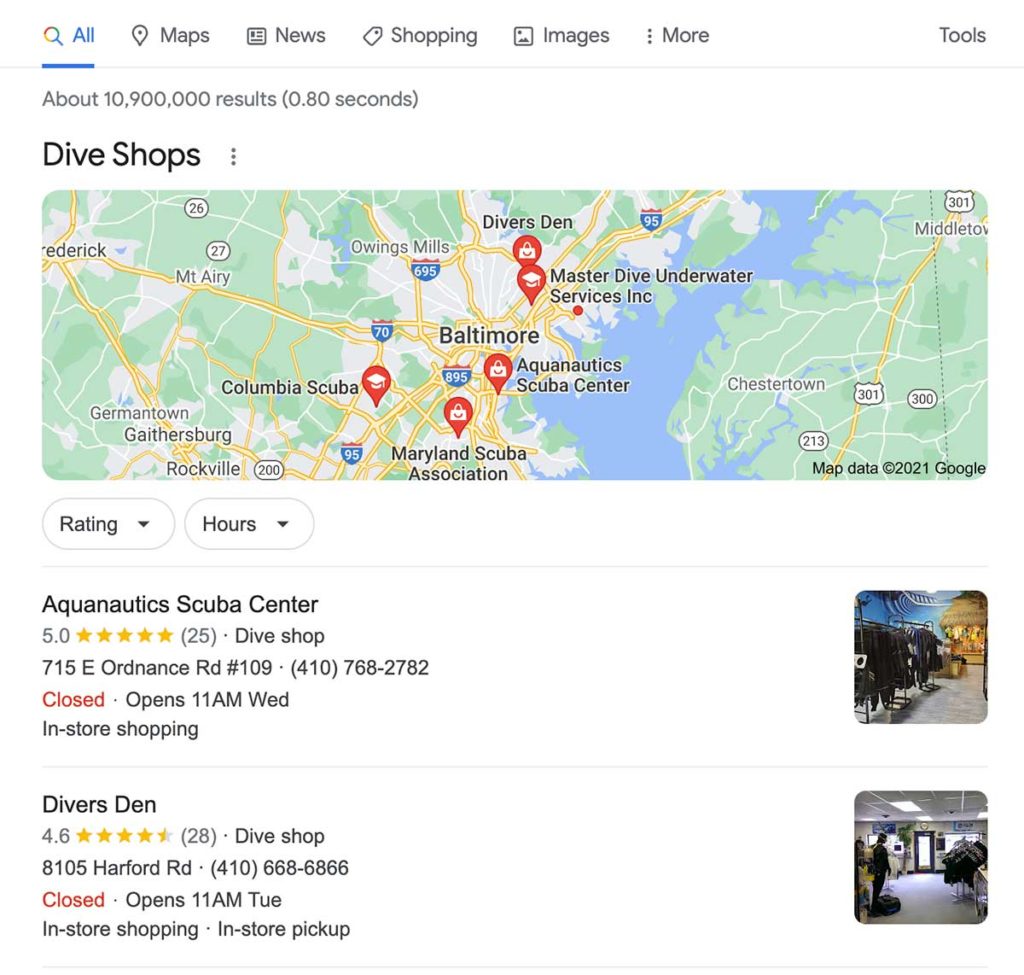Where do your new customers come from? In days past it was primarily word-of-mouth and Yellow Pages advertising.
- Word-of-mouth remains a key component of customer acquisition. It’s just that, today, “word-of-mouth” more often than not means social media.
- Yellow Pages advertising is, of course, a relic of the past, having long been supplanted by Google. A diver who is new in town or someone who wants to become certified will go to Google if they can’t rely on a personal recommendation from friends or family. They may also consult a reputation management site such as Yelp!
Google ain’t want it used to be
Over the years, you’ve undoubtedly been inundated by unsolicited emails offering to “push you to the top of the page” on Google searches. But Google no longer works that way. Hopefully, you already know this. But, if not, try this:
- Open Google in your web browser.
- In the search bar, type in your city and state followed by the words dive shop.
- See what you get.
In most instances, the results will look like this:
What you will see is a map of the area you specified with pins representing all of the dive shops Google recognizes. Below will be a list of those dive centers with key information about each.
Be aware that the order in which dive stores appear on this list generally has little to with old-fashioned Google rankings. Rather, it is usually based on how far the dive center is from the center of the city you specified.
Missing in action?
If your store does not immediately appear on the Google map, it may be because it is located farther out from the city center than the area the map covers. It may still show up in the list of stores below the map.
- Try zooming out and see whether your store shows up. If it does, there may not be much else you can do.
Your greater concern is if your store does not show up at all. In this case, go immediately to Google My Business to add your store to Google. It’s a good idea to do this even if your store does show up. Doing so will give you greater control over how Google shows your listing to visitors.
It’s all in the stars
A feature you will notice when searching for dive stores on Google is that, just below each store name, a customer review rating appears. These are expressed as stars, with five full stars or a 5.0 rating being the highest. Yelp! and others use similar rating systems.
Many dive store owners fail to realize just how important these are. Research shows that more than 60 percent of prospective customers rely on Google reviews when choosing a business. You should know what your store’s rating is and be constantly working to improve it.
Be aware that customers tend to rate dive stores higher than they do other businesses. This may be because most reviewers completed their initial diver training through the shop and think their instructor walks on water (even if he or she does not). Most stores rate 4.5 stars or higher.
- If you store rates lower than this, you should be concerned and start working to improve your ratings.
- If you rate below 4.0 stars, you are in real trouble and need to take immediate action to remedy the situation.
So, what do we mean by this?
The thing you fear most
For store owners who are concerned — as they should be — with reputation management, few things are more dreaded than a negative review. A single one-star review can turn two five-star reviews into an overall rating of 3.7. When your competitors all have star ratings of 4.5 or better, this is something you can ill afford.
- Sometimes, negative reviews come from customers with legitimate concerns. If so, you need to fix the problems and make an all-out effort to provide better customer service.
- More often than not, however, a single negative review amidst a sea of positive ones will come from the person who entered the sport with unrealistic expectations or is the kind of person who is incapable of listening to or following directions.
What makes the second type of negative review particularly frustrating is the fact it’s usually undeserved. So, what can you do about it?
How not to respond to a negative review
When you come across an unjustified negative review, it’s normal to get angry. After all, the complainer is posting inaccurate information that is damaging to your business. You may be tempted to immediately jump in and post a response telling the world why this person is full of it. Don’t do it. What you need to keep in mind is:
- The people reading these reviews don’t know you and don’t know the person posting the negative review. As unfair as it may seem, without evidence to the contrary, readers will tend to believe the person complaining.
- If your response is angry or condescending, readers will assume you are arrogant or a bully. This is not how you want to be perceived.
The best thing you can do is simply wait until you cool down, then think carefully about how you will respond. You do need to respond, however. Otherwise, people will assume the negative review is accurate.
The best way to respond to a negative review
When you come across a negative review on sites like Google or Yelp!, the first thing to ask is, Is this review justified?
- If the review is justified, you need to post a sincere apology, explain that this is not how you normally do business and assure readers you are taking steps to ensure this situation doesn’t happen again.
- If the review isn’t justified, you need to think carefully before responding.
There is no ironclad formula for responding to negative reviews as each situation is different. However, there are some general rules you should follow. These include:
- Don’t make the reviewer out to be the bad guy — especially if he or she is: It doesn’t matter that the person complaining is a total jerk. If you call him out on that fact, you will be the one who looks bad, not him.
- Apologize not for any wrongdoing on your part but for the fact there was a misunderstanding: In other words, express regret over the misunderstanding without admitting that you did anything wrong (especially if you didn’t).
- Clarify your position…nicely: If your store has a policy the customer doesn’t like, clarify not only what the policy is but why it is necessary.
- Stress your commitment to good customer service: Make sure that anyone who reads the negative review and your response understands how hard you work to ensure every customer experience is a happy one.
- Keep it brief: A response of any more than one or two short paragraphs is one prospective customers won’t read. Keep it simple. Keep it short.
Some examples
Here are two examples.
- One shows how not to respond to a negative review.
- The other shows a more positive response that will make you look better in the eyes of prospective customers.
Both of these examples are in response to a beginning course student who complained about having to pay out of pocket for dive site admission during his open-water training dives. Here is the first response.
You were obviously not paying attention. We explain the costs associated with getting certified very clearly on our website, in our class handout and again during the first class session. Reading and listening to directions is an important part of being a certified diver. If you are unable to do so, we clearly made a mistake in certifying you.
Obviously, this type of response will not win you any friends — despite the fact it is entirely justified. You may know that the person complaining is a total jerk. Unfortunately, others will not. Here is a better way to handle things.
We were saddened to hear that your open-water training experience was anything less than positive. The only reason we do not include dive site admission in the cost of the course is that it will vary from site to site. And, on any given day, we choose sites based on weather and conditions. Providing the best possible customer experience is important to us. Please feel free to call or stop by the store to tell us what we can do to avoid situations like this in the future.
Obviously, the latter response is the better one.
- It expresses regret while not admitting any wrongdoing.
- It doesn’t make the complainer out to be the total jerk that he obviously is.
- It clarifies your store’s policy and makes it sound reasonable.
- It underscores your commitment to the best possible customers experiences.
In other words, it is more likely to win over prospective customers rather than alienate them.
Responding to positive reviews
While responding to negative reviews is important, it is equally important to respond to the many positive ones. Why?
- It makes you look even better in the eyes of prospective customers.
- It provides an opportunity to promote additional training, travel and equipment purchases. (Just don’t oversell.)
- It encourages others to pose positive reviews so that they, too, can get a pat on the back from you.
The stores we know who do this appear to be doing substantially better than those who do not.
“Cancelling” negative reviews
While it’s important to respond to any negative reviews on Google, Yelp! and similar platforms, this by itself will not raise your customer satisfaction rating. Making matters worse, no matter how unfounded a negative review is, Google will not delete it, no matter how much you want them to.
From Google’s point of view, they’ve given you the opportunity to respond to negative reviewers. And, if the review is truly libelous, you can always take the reviewer to court. From the perspective of Google, Yelp! and similar sites, this is sufficient. It does not, however, help with your tarnished star rating. So what can you do?
The best way to “cancel” a negative review is with an overwhelming number of positive ones. In other words, if you offset a single one-star review with four five-star reviews, you will raise the average score for all five reviews to 4.2. This will help.
Does this mean, however, that you should immediately rally a dozen of your best customers to jump online and write a glowing review of your business? This is where things get tricky.
Does anyone know how Google thinks?
Google and similar sites are notoriously tight-lipped about how their algorithms manage reviews and the responses to those reviews. It is best, then, to err on the side of caution. Here are some things that may cause Google to flag a positive review as suspicious:
- Multiple reviews from the same person: The typical reviewer only posts once. Any more than this from the same person will likely raise flags.
- A sudden flurry of positive reviews: Let’s say your business typically gets three or four reviews every week. Suddenly, within the space of a couple of days, there are two dozen reviews, all of them positive. Do you really think this will look like anything other than an attempt to manipulate your store’s rating artificially?
- Suspiciously similar reviews: If you recruit friends and customers to post positive reviews, don’t put words in their mouths. Google will most likely see a pattern and raise a flag.
- Artificial-sounding reviews: This is another problem with trying to script your customers’ reviews. Unless they sound like something a normal human being would write, they will strike Google and similar sites as suspicious.
Bear in mind, what we just shared was conjecture — although it makes sense. Google will neither confirm nor deny this is what they do. But there are a number of reputation management companies out there that will offer to raise your Google and other rankings artificially. You can bet that Google has used its considerable resources to protect the integrity of its customer satisfaction rankings.
You need to be proactive
If trying to offset a negative review after the fact may only raise flags with Google and similar sites, what is the better alternative? It’s to ensure you have a steady stream of positive reviews coming in on a regular basis.
How do you do this? One thing is for certain: You can’t simply wait around and hope it happens. If you want a steady stream of good reviews, you need to ask for them.
Of course, who you ask is important.
- You probably don’t want to ask the customers whose boat dive was plagued by high seas and mechanical problems. Even though none of this may have been your fault, you can’t expect people to speak glowingly about their experience.
- The best people to ask are your recent beginning course graduates. They are the ones who usually think your and your instructional staff walk on water. Learning to scuba dive can be a life-changing experience — one students are eager to share with others.
One store we know offers recent Open Water course graduates a discount on Nitrox Diver certification if they post a review on Google. Doing this not only results in good reviews but an increase in Nitrox certs.
Of course, any customer whom you feel has had a positive experience with you or your staff is someone you should ask for a review.
- Once source recommends doing this via SMS (i.e., text messages). This way, customers can post a review directly from their phone as soon as they get your message.
- Of course, the text you send will need to include the URL to post a Google review for your business. You can do this by going to your business’s page on Google and clicking on the Write a Review button. Then copy the link in the address bar at the top of the screen and save it. Add this to the end of each of your text messages.
Don’t forget about Facebook
Thus far we’ve discussed Google, Yelp! and similar sites. It’s equally important to manage your customer reviews on Facebook. To do so, you will need to make sure your reviews are visible. Assuming your business has a Facebook page, this is easy to do. To learn how just Google Show Facebook page reviews.
You need to take this seriously
Reputation management is not something you can do whenever the mood strikes you. You should be allocating at least 15 minutes a day to this.
The bad news is, if you are not doing this, you have no way of knowing how much it is costing you. On the other hand, if you are doing this or start doing this, you will see the results increase steadily over time.



